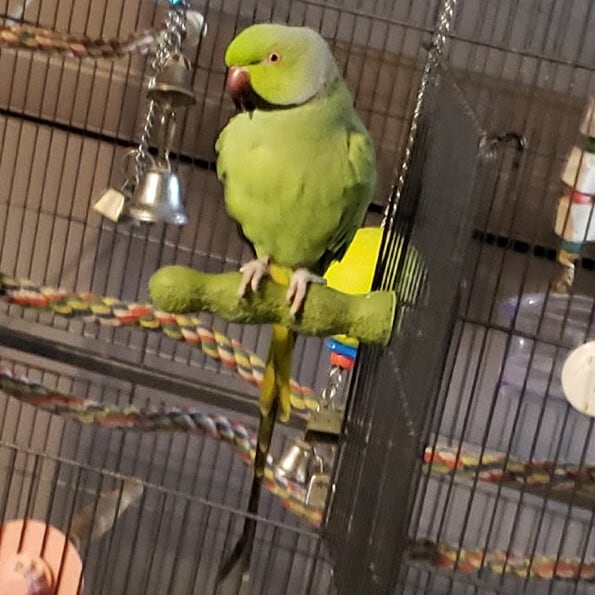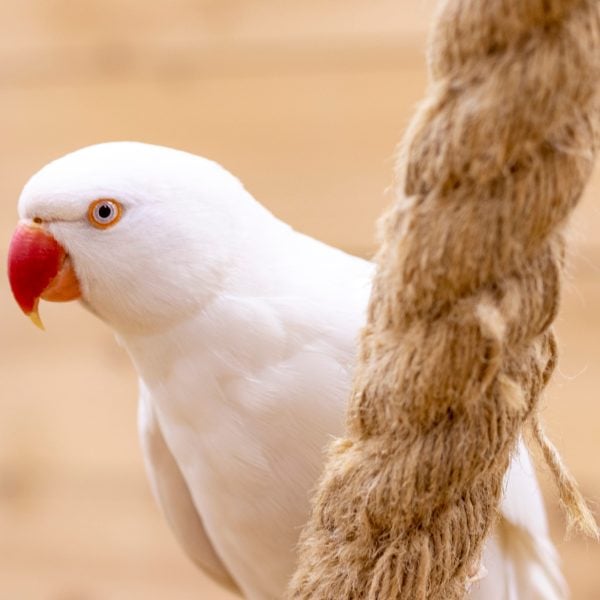Last Updated on by Mitch Rezman
In a recent post, I mentioned learned helplessness and promised you a detailed explanation of what it means, its impacts, and how it happens so that you can avoid making this huge mistake in taming or training your own parrot or companion bird.
I mentioned that it has impacts on personality as well as desire and ability to learn, immune system response, plus it can cause depression and even reduce the bird’s will to live.
You can easily see that learned helplessness is serious just from the problems that can result from making this mistake with a bird.
Wikipedia’s opening words about learned helplessness annotate research sources and state:
“Learned helplessness is behavior typical of an organism (human or animal) that has endured repeated painful or otherwise aversive stimuli which it was unable to escape or avoid. After such experience, the organism often fails to learn to escape or avoid new situations where such behavior would be effective.”
In other words, the organism seems to have learned that it is helpless in aversive situations, that it has lost control, and so it gives up trying.
Such an organism is said to have acquired learned helplessness.” Sounds scary, doesn’t it?
To state that same in my own, simpler words means that an organism has learned that situations that are negative, bad, scary, or stressful can’t be controlled or avoided by the actions of that organism to which they are happening.
For example, there are people who advocate that a parrot will learn to enjoy being scratched and petted if you capture the bird, wrap it in a towel against its will, and then stroke and pet it while it is restrained.
Now, think about this whole idea a bit but from YOUR point of view, as if it were happening to you.
Let’s say for this example that you are a small woman (the bird) and you are restrained by a very large very strong man (the human).
Find the Windy City Parrot Training and Behavior Category Here
The person restraining you against your will strokes your hair tickles you and otherwise makes non-sexual contact with your body while you are unwillingly restrained.
Then imagine this happens over and over again, whenever the larger, stronger person chooses to restrain you again.
Soon you would learn that no matter what you do you simply can’t control the situation.
Keep in mind, large parrots think on the level of 2-5-year-old humans and even small parrots think like toddlers.
Controlled research experiments that were performed with young babies gave one group control over a pillow that turned on the spinning of an interesting toy mobile hanging over their cribs while another group was only allowed to look at the same interesting mobile hanging over their cribs.
When the babies were all given the pillows that provided the choice to control causing the hanging mobile to move, the babies previously unable to control the toy mobiles failed to learn that they now had control over the situation.
In this situation, the babies developed the condition known as learned helplessness over the interesting toy, even when shown that the pillows controlled the toys by moving their heads on it.
The whole point that runs through each of these scenarios is that the baby, older human, or parrot is given no choice about controlling their situation. They do not get the option of saying, “No, I don’t want that to happen to me.” If you have been around parrots for a while, you likely know that sometimes a bird wants to simply not perform a trick or not come out of its cage when you want them to, even when they know what you are asking it to do. It wants to have some choice over its situation.
The same parrot that doesn’t want to perform a trick when you want to show the new trick to your friend will likely be more than willing to respond to the request when you say the word you have taught the bird to respond to at another time.
Choice can mean a lot in building trust with your parrot while learned helplessness removes trust.
Because of learned helplessness, if a human repeatedly restrains the bird and pets it against its will, over time it will begin to relax and even accept the petting.
However, it is not doing so because it trusts the human enough to allow its head or body to be touched; it is doing so because it knows it has no choice and might as well not struggle. This is a perfect example of learned helplessness.
Feed an aggressive Amazon & not get bit by building a trust bond (and maybe a spoon)
Now that you know what learned helplessness is, let’s look at what learned helplessness can do to a bird. A group of puppies was taught learned helplessness in a 1976 experiment.
They were then tested along with puppies that had not learned helplessness. When the researchers taught both groups of puppies a new behavior — simply to flee the situation — two-thirds of the puppies that had been exposed to learned helplessness failed to learn the behavior even though it was simply to escape.
The puppies not exposed to learned helplessness all very quickly learned the behavior. Other experiments with rats and other animals have proven the same results — lack of motivation to learn new behaviors or solve problems.
To avoid teaching learned helplessness, you should always give the parrot choice and allow it to learn a behavior along with your patient teaching.
First, you must define the behavior you want to teach, whether it is stepping up, taking food from your hand, being touched for scratching, or another behavior.
Then break that behavior down into the simplest steps possible. Let’s look at the steps for the behavior of simply coming out of the cage, one of the first steps of training and building trust.
Of course, you would define a reward that the bird loves and you may want to look into clicker training and use a clicker. I personally haven’t done clicker training but I may start.
Clicker Training Videos for Birds on Windy City Parrot – From Tricks to Flight
The bird is in the cage.
First, read the bird’s body language to see if it is willing to work with you at this time.
Next is opening the door of the cage, of course. Then say the command you have chosen to invoke this behavior, perhaps “come out” and offer the high-value reward.
At first, the bird might only take one step toward the door and stop, but it is a step.
Reward the movement toward the door by placing the treat in the bird’s food dish. The next time, patiently wait for the bird to take at least two steps toward the door before rewarding it. Repeat these small steps until the bird actually reaches the door of the cage through its own will and desire and takes the reward directly from your hand… This builds trust because you are not forcing the bird to do anything — you are asking it to do something instead.

A tool we use on all our birdcages is to install a Hagen Grooming Perch
inside the cage door so the bird can be “outside of the cage” while still being “on” the cage.
How many of you reading this has experienced a “one person” bird?
This process can be used for initial taming, further training, and building a positive relationship with a parrot so that it knows it has a choice to perform the action and get a treat or reward or simply not perform the action.
The bird has control of its decision to act or not.
While this may sound counter-intuitive to some who have read not to let the bird refuse to perform or get away with anything (domination training is what that is called), it is the only way a bird will trust you not to force it, unnecessarily restrain it and it will learn to enjoy your company and contact with it. It will become a smarter, healthier, happier bird that really considers you its flock.
It will also be willing to learn other new behaviors faster because the first experience was a fun, positive one.
I hope this helps some of you better understand the training process. You can further research learned helplessness at many websites on the internet, but this is the basic idea that you must avoid if you want your bird to trust you and be happy.
Written by the Windy City Parrot content team
Author Profile
Latest entries
 The Traveling BirdJune 26, 2025Can You Name 5 Parrot Species That Are Living Wild in the USA?
The Traveling BirdJune 26, 2025Can You Name 5 Parrot Species That Are Living Wild in the USA? Bird BehaviorJune 26, 2025How is it Parrots Are Problem Solvers Social Animals and Even Use Tools?
Bird BehaviorJune 26, 2025How is it Parrots Are Problem Solvers Social Animals and Even Use Tools? Bird & Parrot AnatomyJune 25, 2025How a Tiny Chemical Modification Makes Parrots Nature’s Living Paintings
Bird & Parrot AnatomyJune 25, 2025How a Tiny Chemical Modification Makes Parrots Nature’s Living Paintings PigeonsJune 20, 2025How Do Parrots Thrive in Cities Outside Their Native Habitats?
PigeonsJune 20, 2025How Do Parrots Thrive in Cities Outside Their Native Habitats?




